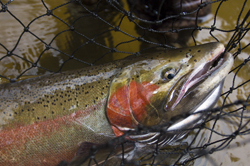By Louie Stout
 Trout/salmon returns have biologists concerned.Some weird stuff is going on with trout and salmon this fall and St. Joseph River anglers are likely to suffer from it.
Trout/salmon returns have biologists concerned.Some weird stuff is going on with trout and salmon this fall and St. Joseph River anglers are likely to suffer from it.
Biologists are deeply concerned. If youve been fishing for steelhead, you probably are, too. Only 632 Skamania steelhead have passed through the South Bend ladder. And they are puny.
The problem isnt just here, but lake-wide for most salmonids.
King salmon, for example, are almost non-existent in rivers and streams. Indiana usually relies on Michigan kings for brood stock, but the return has been so bad up there that Hoosier fish managers had to drive to Wisconsin to get what they could.
Its the worse fall run Ive seen in 25 years, said Bodine Assistant Hatchery Manager Bob Bell. Its a very, very bad situation that we hope will turn around.
Lake Michigan biologist Brian Breidert concurs. He said we should have seen thousands of steelhead and some kings by now and the ones returning to the river arent in good shape.
They havent had an opportunity to feed appropriately because theres only one decent alewife class in the lake and very limited alternative food sources for them, said Breidert.
To make matters worse, an ongoing study of the lakes alewife populations is returning dismal results. Next years fishing may not be any better.
Now, if youre looking for a bright spot and it isnt exactly a shining moment coho numbers in the river were approaching 1,300 this week. Thats pretty good, and those fish are healthy.
There are various theories being bantered among biologists as to whats going on. First, everyone agrees the big lakes alewife population is dangerously low.
That could explain the problems with steelhead and kings that are dependent on them as a primary food source.
Coho, Breidert said, have been capitalizing on a good yellow perch spawn earlier in the year sort of a good news/bad news item for perch fishermen, whove been hoping for a rebound in perch numbers. But if coho have been gobbling them up, what will that do to future perch populations?
Coho stocking are another concern. Indiana gets those eggs from the Platte River in Michigan, but the fish arent ready to spawn.
Its running a week or two behind, noted Breidert. And thats unusual.
But back to the steelhead. Does the low return mean a lot of fish died of starvation?
Breidert hopes not. His hunch is that last years large run of 3 year olds that spawned here prematurely last April couldnt find enough to eat and didnt replenish their eggs for this years run. So they stayed in the lake.
Were hoping the winter steelhead (a different type of steelhead) that come in later (early winter) will return in better shape, he said.
The bottom line is Lake Michigan is a very unstable ecosystem and trout and salmon are extremely dependent upon alewife populations. Also, remember that trout and salmon arent native to the lake and there are a lot dynamics going on out there right now.
As Breidert pointed out, an alarming number of quagga mussels have been draining the lower end of the food web of tiny organisms that alewives and other young fish are dependent upon to survive. When the bottom of the food chain takes a severe hit, gamefish eventually suffer, too.
Droughts, he added, have plagued fish returns in years past. With low water, some fish dont make it up the river where they spawn.
In 2013, biologists reduced king salmon stocking numbers dramatically, hoping to reduce the number of aggressive mouths in the lake and take pressure off the alewife population.
Thats hurt fishing for the prized salmon, but it also may have avoided a complete crash of the food chain.
Fish managers are doing the best we can with what we have to work with, he said. Mother Nature holds.